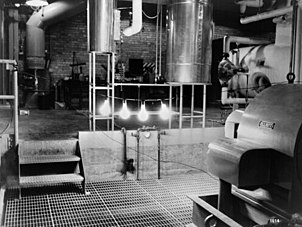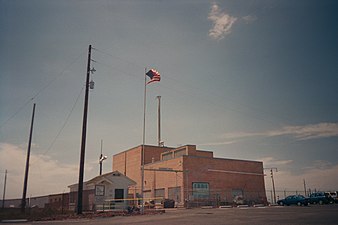energy.wikisort.org - Power_plant
Experimental Breeder Reactor I (EBR-I) is a decommissioned research reactor and U.S. National Historic Landmark located in the desert about 18 miles (29 km) southeast of Arco, Idaho. It was the world's first breeder reactor.[3] At 1:50 p.m. on December 20, 1951, it became one of the world's first electricity-generating nuclear power plants when it produced sufficient electricity to illuminate four 200-watt light bulbs.[4][5] EBR-I subsequently generated sufficient electricity to power its building, and continued to be used for experimental purposes until it was decommissioned in 1964. The museum is open for visitors from late May until early September.
Experimental Breeder Reactor No. 1 | |
U.S. National Register of Historic Places | |
U.S. National Historic Landmark | |
 Experimental Breeder Reactor Number 1 in Idaho, the first power reactor | |
  | |
| Location | Butte County, Idaho, US |
|---|---|
| Nearest city | Arco, Idaho |
| Coordinates | 43.51132°N 113.0064°W |
| Built | 1950 |
| Architect | Atomic Energy Commission |
| NRHP reference No. | 66000307 |
| Significant dates | |
| Added to NRHP | October 15, 1966[1] |
| Designated NHL | December 21, 1965[2] |
History
As part of the National Reactor Testing Station (since 2005 Idaho National Laboratory), EBR-I's construction started in late 1949. The reactor was designed and constructed by a team led by Walter Zinn at the Argonne National Laboratory[6] Idaho site, known as Argonne-West. In its early stages, the reactor plant was referred to as Chicago Pile 4 (CP-4) and Zinn's Infernal Pile.[7] Installation of the reactor at EBR-I took place in early 1951 (the first reactor in Idaho) and it began power operation on August 24, 1951. On December 20 of that year, atomic energy was successfully harvested at EBR-1 for the first time. The following day, the reactor produced enough power to light the whole building. The power plant produced 200 kW of electricity out of 1.4 MW of heat generated by the reactor.[8]

The design purpose of EBR-I was not to produce electricity but instead to validate nuclear physics theory that suggested that a breeder reactor should be possible. In 1953, experiments revealed the reactor was producing additional fuel during fission, thus confirming the hypothesis. On November 29, 1955, the reactor at EBR-I suffered a partial meltdown during a coolant flow test. The flow test was trying to determine the cause of unexpected reactor responses to changes in coolant flow. It was subsequently repaired for further experiments, which determined that thermal expansion of the fuel rods and the thick plates supporting the fuel rods was the cause of the unexpected reactor response.[9]
Although EBR-I produced the first electricity available in-house, a nearby experimental boiling water reactor plant called BORAX-III (also designed, built, and operated by Argonne National Laboratory) was connected to external loads, powering the nearby city of Arco, Idaho in 1955, the first time a city had been powered solely by nuclear power.[10]
Besides generating the world's first electricity from atomic energy, EBR-I was also the world's first breeder reactor and the first to use plutonium fuel to generate electricity (see also the Clementine nuclear reactor). EBR-I's initial purpose was to prove Enrico Fermi's fuel breeding principle, a principle that showed a nuclear reactor producing more fuel atoms than consumed. Along with generating electricity, EBR-1 would also prove this principle.[11]
Design
This section needs expansion. You can help by adding to it. (October 2019) |
EBR-I used uranium metal fuel and NaK primary coolant.[12] It was in this identical to the initial configuration of the later Dounreay Fast Reactor which first went critical in 1959.
Decommission and legacy
EBR-I was deactivated by Argonne in 1964 and replaced with a new reactor, Experimental Breeder Reactor II.
It was declared a National Historic Landmark in 1965[2][13] with its dedication ceremony held on August 25, 1966, led by President Lyndon Johnson and Glenn T. Seaborg.[14] It was also declared an IEEE Milestone in 2004.[15]
Gallery
- Plaques at the EBR-I site
 Assembly of the EBR-1 core in 1951
Assembly of the EBR-1 core in 1951
 The first production of usable nuclear electricity occurred on December 20, 1951, when four light bulbs were lit with electricity generated from the EBR-1 reactor.
The first production of usable nuclear electricity occurred on December 20, 1951, when four light bulbs were lit with electricity generated from the EBR-1 reactor.- The reactor is in the building at center; the two structures lower left are reactors from the Aircraft Nuclear Propulsion Project.
- View of EBR-1, from the parking lot
See also
- Argonne National Laboratory
- Obninsk Nuclear Power Plant, 5MWe, the first nuclear reactor to supply electricity to a power grid.
- Calder Hall, England, the first nuclear power station to deliver power in commercial quantities.
- Aircraft Nuclear Propulsion Project
- Idaho National Laboratory
- List of National Historic Landmarks in Idaho
- National Register of Historic Places listings in Butte County, Idaho
References
- Citations
- "Experimental Breeder Reactor No. 1". NPGallery. National Park Service. Retrieved October 27, 2018.
- "Experimental Breeder Reactor No. 1". National Historic Landmark summary listing. National Park Service. Archived from the original on January 10, 2008. Retrieved February 6, 2008.
- "Breeder reactor". Encyclopedia Britannica. Retrieved December 31, 2017.
- "EBR-I (Experimental Breeder Reactor-I)". Argonne National Laboratory.
- Rick Michal (November 2001). "Fifty years ago in December: Atomic reactor EBR-I produced first electricity" (PDF). Nuclear News. American Nuclear Society.
- "Nuclear Reactors Built, Being Built, or Planned in the United States as of June 30, 1970". U.S. Department of Energy, Office of Scientific and Technical Information. October 31, 1970. doi:10.2172/4115425.
{{cite journal}}: Cite journal requires|journal=(help) - Argonne’s Nuclear Science and Technology Legacy: Chicago Pile reactors create enduring research legacy part of the Argonne National Laboratory Highlights in the period 1942–1949
- "Nuclear energy for peace: the birth of nuclear energetics". Archived from the original on July 26, 2011. Retrieved July 21, 2009.
- The Story of the Borax Nuclear Reactor and the EBR-I Meltdown — Ray Haroldsen ISBN 978-1-56684-706-3
- "AEC Press release for BORAX-III lighting Arco, Idaho". U.S. Department of Energy, Argonne National Laboratory. 1999. Retrieved July 26, 2012.
- "Experimental Breeder Reactor I". ASME. Retrieved December 18, 2017.
- "Experimental Breeder Reactor I" (PDF). ASME. Retrieved October 28, 2019.
- Blanche Higgins Schroer (June 12, 1976). "Experimental Breeder Reactor #1" (PDF). National Register of Historic Places Inventory Nomination Form. National Park Service. Retrieved June 22, 2009. and Accompanying 4 photos, from 1975. (1.43 MB)
- "EBR-I now open to the public for tours". Idaho National Laboratory. May 26, 2016. Retrieved December 18, 2017.
- "Milestones:Experimental Breeder Reactor I, 1951". IEEE Global History Network. IEEE. Retrieved August 3, 2011.
- Bibliography
- Argonne National Laboratory EBR-1 – The EBR-1 reactor was designed, built, and operated by Argonne National Laboratory.
- Page about EBR-1 at INL web site
- IEEE History Center: EBR-I
- INL EBR-1
- ANS EBR-I History
- Essay by Matthew Croson
- Atomic Heritage Foundation
External links
- Official website
- "Reactor Makes Electricity". Popular Mechanics. 97 (3): 105. March 1952.
- "Nuclear Pioneers: Creation of the Experimental Breeder Reactor 1" on YouTube "How the reactor was developed through interviews with the original researchers". Idaho National Lab (INL). April 13, 2011.
{{cite web}}: Missing or empty|url=(help) - ERB-1 Core Disassembly
Другой контент может иметь иную лицензию. Перед использованием материалов сайта WikiSort.org внимательно изучите правила лицензирования конкретных элементов наполнения сайта.
WikiSort.org - проект по пересортировке и дополнению контента Википедии




